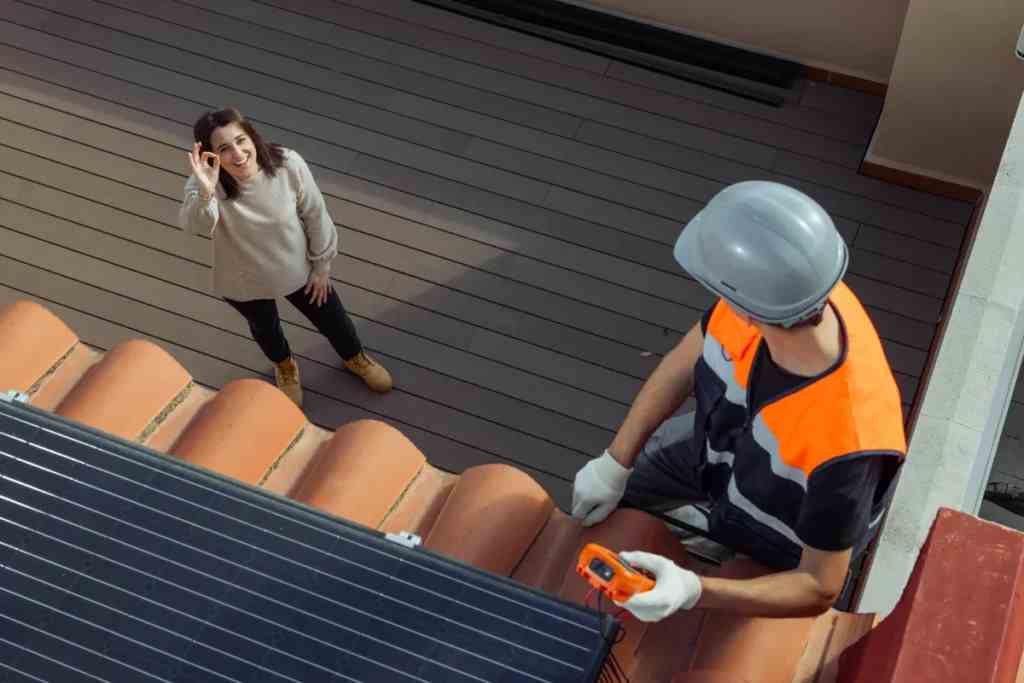The installation process for various roofing materials can differ significantly, impacting the overall durability, appearance, and cost of a roof. Asphalt shingles, metal roofing, slate, and tile each require distinct methods and expertise. Metal roofing, known for its longevity and energy efficiency, involves precise measurements and specialized fastening techniques. Slate and tile, while offering superior aesthetic appeal and durability, demand meticulous placement and additional structural support due to their weight. Understanding these differences, Angel Construction Broker LLC helps homeowners and contractors alike to ensure a successful and long-lasting roofing project.
Asphalt Shingles
Asphalt shingles are one of the most popular roofing materials in North America due to their affordability, durability, and ease of installation. The process begins with the preparation of the roof deck. Old roofing material is removed, and any damage to the deck is repaired. This step is crucial to ensure a smooth and stable base for the new shingles.
The roofing installation process by using the asphalt shingles, begins at the bottom edge of the roof and progresses upward in a staggered pattern. Each shingle is overlapped to ensure proper water shedding and wind resistance. Flashing is installed around roof penetrations, such as chimneys and vents, to prevent water from seeping through gaps. Finally, ridge cap shingles are installed along the roof peak to provide a finished look and additional protection against wind and rain.
Metal Roofing
Metal roofing is known for its longevity, energy efficiency, and modern aesthetic. The installation process for metal roofing starts with the preparation of the roof deck. Similar to asphalt shingles, old roofing material is removed, and any necessary repairs to the deck are made.
The installation of metal panels or shingles begins at the bottom edge of the roof. Panels are typically secured with screws or clips, and it’s crucial to ensure that each panel is properly aligned and overlapped to prevent leaks. Flashing is installed around roof penetrations and edges to further protect against water infiltration. A metal ridge cap is installed along the roof peak to complete the installation, providing a finished appearance and additional protection.
Clay or Concrete Tiles
Clay and concrete tiles are prized for their durability, fire resistance, and distinctive appearance. The installation process for these heavy materials starts with the preparation of the roof deck, which involves removing old roofing material and making necessary repairs.
Tile installation begins at the bottom edge of the roof, with each tile secured using nails or clips. The weight of the tiles requires careful handling and precise placement to ensure stability. Flashing is installed around roof penetrations, and ridge tiles are placed along the roof peak to complete the installation. The result is a visually striking roof that offers excellent protection and longevity.
Slate Roofing
Slate roofing is known for its elegance, durability, and long lifespan. The installation process for slate tiles is meticulous and requires skilled craftsmanship. The roof deck is prepared by removing old roofing material and repairing any damage.
Slate tiles are installed starting from the bottom edge of the roof. Each tile is secured with nails or hooks, and the installation progresses upward in rows. Proper alignment and spacing are critical to ensure the tiles’ stability and aesthetic appeal. Flashing is installed around roof penetrations, and ridge tiles or specialized ridge caps are placed along the roof peak to complete the installation. The result is a roof that combines timeless beauty with exceptional durability.
Wood Shingles or Shakes

Wood shingles and shakes offer a natural, rustic charm and are commonly used for residential roofing. The installation process begins with the preparation of the roof deck, which involves removing old roofing material and repairing any damage.
A breathable underlayment is installed to allow for proper ventilation and moisture control. This is particularly important for wood roofing, as it helps prevent rot and extends the lifespan of the shingles or shakes. The installation of wood shingles or shakes starts at the bottom edge of the roof. Each piece is carefully spaced to allow for expansion and contraction due to temperature and moisture changes. The shingles or shakes are secured with nails, and the installation progresses upward in rows.
Flat Roofing (EPDM, TPO, Modified Bitumen)
Flat roofing materials, such as EPDM, TPO, and modified bitumen, are commonly used for commercial buildings and modern residential designs. The installation process for flat roofs involves several specialized steps.
The roof deck is prepared by removing old roofing material and making any necessary repairs. Insulation boards may be installed to enhance energy efficiency and provide a stable base for the roofing material.
Flashing is installed around roof penetrations and edges to prevent water infiltration. The final step involves sealing all seams and edges to ensure a fully waterproof installation. Flat roofs require regular maintenance to ensure their longevity and performance, but they offer a versatile and efficient roofing solution.
Green Roofs
Green roofs, also known as living roofs, are covered with vegetation and soil, providing numerous environmental benefits. The installation process begins with the preparation of the roof deck. It must be thoroughly cleaned, and any necessary repairs must be made to ensure a stable base.
A filter layer is then placed over the drainage layer to prevent soil particles from clogging the drainage system. Finally, a growing medium (soil) is spread over the filter layer, and vegetation is planted. The choice of plants depends on the local climate and the roof’s ability to support their weight. Green roofs require regular maintenance, including watering, fertilizing, and weeding, to ensure the health and longevity of the vegetation.
Solar Roofs
Solar roofs integrate solar panels with traditional roofing materials, allowing homeowners to generate electricity while maintaining a conventional roof appearance. The installation process for solar roofs begins with a structural assessment of the roof to ensure it can support the additional weight of the solar panels.
The solar panels are installed in rows, starting from the bottom edge of the roof and working upward. Each panel is connected to the mounting brackets and wired to the electrical system. Flashing is installed around roof penetrations to prevent water infiltration. Finally, a solar inverter is installed to convert the direct current (DC) electricity generated by the panels into alternating current (AC) for use in the home. Solar roofs provide clean, renewable energy and can significantly reduce electricity bills.
Composite Roofing
Composite roofing materials, made from a blend of asphalt, fiberglass, and recycled materials, offer durability and versatility. The installation process for composite roofing begins with the preparation of the roof deck. Old roofing material is removed, and any necessary repairs are made to create a stable base.
The installation of composite shingles begins at the bottom edge of the roof and progresses upward in a staggered pattern. Each shingle is overlapped to ensure proper water shedding and wind resistance. Flashing is installed around roof penetrations, such as chimneys and vents, to prevent water from seeping through gaps. Finally, ridge cap shingles are installed along the roof peak to provide a finished look and additional protection against wind and rain. Composite roofing is known for its low maintenance requirements and long lifespan.

Built-Up Roofing (BUR)
Built-up roofing (BUR) is a traditional flat roofing system that consists of multiple layers of asphalt and reinforcing fabrics. The installation process for BUR begins with the preparation of the roof deck, which involves removing old roofing material and making necessary repairs.
The final layer of bitumen is topped with a protective surface layer, such as gravel or a reflective coating, to protect the roofing material from UV radiation and weathering. Flashing is installed around roof penetrations and edges to prevent water infiltration. BUR systems are known for their durability and ability to withstand extreme weather conditions.
Synthetic Roofing
Synthetic roofing materials, such as synthetic slate or shake, are designed to mimic the appearance of natural materials while offering enhanced durability and lower maintenance requirements. The installation process for synthetic roofing begins with the preparation of the roof deck. Old roofing material is removed, and any necessary repairs are made to create a stable base.
Flashing is installed around roof penetrations, such as chimneys and vents, to prevent water from seeping through gaps. Ridge caps are installed along the roof peak to provide a finished look and additional protection against wind and rain. Synthetic roofing materials are lightweight, resistant to impact and weathering, and often come with extended warranties.
Cedar Roofing
Cedar roofing, whether in the form of shingles or shakes, offers a natural, rustic aesthetic and excellent insulation properties. The installation process for cedar roofing begins with the preparation of the roof deck. Old roofing material is removed, and any necessary repairs are made to create a stable base.
The installation of cedar shingles or shakes starts at the bottom edge of the roof. Each piece is carefully spaced to allow for expansion and contraction due to temperature and moisture changes. The shingles or shakes are secured with nails, and the installation progresses upward in rows. Finally, ridge caps or shakes are installed along the roof peak to provide a finished look and additional protection against wind and rain. Cedar roofing requires regular maintenance, including cleaning and treatment, to prevent moss and algae growth and ensure longevity.
Conclusion
Choosing the right roofing material involves considering various factors, including aesthetics, durability, cost, and installation complexity. Asphalt shingles offer affordability and ease of installation, while metal roofing provides durability and energy efficiency. Tile roofing is valued for its aesthetic appeal and longevity, and wood shakes or shingles offer a natural, rustic look. Slate roofing, although expensive and labor-intensive, provides unmatched beauty and longevity. By understanding these differences, homeowners can make informed decisions that best suit their needs and preferences.
